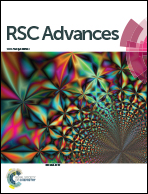A spectroscopic study to decipher the mode of interaction of some common acridine derivatives with CT DNA within nanosecond and femtosecond time domains
Abstract
Acridine and other derivatives of this class are very familiar as DNA intercalators. We, in our present contribution, have made an attempt to decipher the exact mode of interaction of acridine and some of its derivatives, e.g. acridine yellow, proflavine and acridine orange, with calf thymus DNA (CT DNA). Primarily, all these molecules undergo intercalation inside DNA. The simple acridine molecule undergoes complete intercalation. However, the derivatives with flanking substituents have to traverse some steps before intercalation which favor subsequent photoinduced electron transfer (PET) with DNA bases. Steady state and time resolved spectroscopic studies within nanosecond to subpicosecond time regimes have revealed the exact timescale of the stepwise intercalation and PET. It has been seen that bound water molecules in the near vicinity of the DNA molecule play a pivotal role in determining the timescales. The structure of bound water and its exchange with surrounding bulk water often play an important role in many processes of life involving DNA. Moreover, our investigation clearly depicts how the increased number of electron donating side groups present in the derivatives becomes the deciding factor, both electronically and sterically, in controlling the differential behavior of the individual molecules towards PET in a CT DNA environment.


 Please wait while we load your content...
Please wait while we load your content...